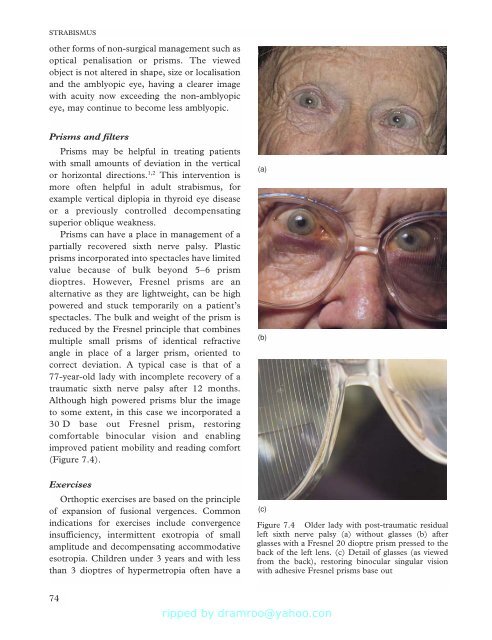Strabismus - Fundamentals of Clinical Ophthalmology.pdf
Strabismus - Fundamentals of Clinical Ophthalmology.pdf
Strabismus - Fundamentals of Clinical Ophthalmology.pdf
You also want an ePaper? Increase the reach of your titles
YUMPU automatically turns print PDFs into web optimized ePapers that Google loves.
STRABISMUS<br />
other forms <strong>of</strong> non-surgical management such as<br />
optical penalisation or prisms. The viewed<br />
object is not altered in shape, size or localisation<br />
and the amblyopic eye, having a clearer image<br />
with acuity now exceeding the non-amblyopic<br />
eye, may continue to become less amblyopic.<br />
Prisms and filters<br />
Prisms may be helpful in treating patients<br />
with small amounts <strong>of</strong> deviation in the vertical<br />
or horizontal directions. 1,2 This intervention is<br />
more <strong>of</strong>ten helpful in adult strabismus, for<br />
example vertical diplopia in thyroid eye disease<br />
or a previously controlled decompensating<br />
superior oblique weakness.<br />
Prisms can have a place in management <strong>of</strong> a<br />
partially recovered sixth nerve palsy. Plastic<br />
prisms incorporated into spectacles have limited<br />
value because <strong>of</strong> bulk beyond 5–6 prism<br />
dioptres. However, Fresnel prisms are an<br />
alternative as they are lightweight, can be high<br />
powered and stuck temporarily on a patient’s<br />
spectacles. The bulk and weight <strong>of</strong> the prism is<br />
reduced by the Fresnel principle that combines<br />
multiple small prisms <strong>of</strong> identical refractive<br />
angle in place <strong>of</strong> a larger prism, oriented to<br />
correct deviation. A typical case is that <strong>of</strong> a<br />
77-year-old lady with incomplete recovery <strong>of</strong> a<br />
traumatic sixth nerve palsy after 12 months.<br />
Although high powered prisms blur the image<br />
to some extent, in this case we incorporated a<br />
30 D base out Fresnel prism, restoring<br />
comfortable binocular vision and enabling<br />
improved patient mobility and reading comfort<br />
(Figure 7.4).<br />
Exercises<br />
Orthoptic exercises are based on the principle<br />
<strong>of</strong> expansion <strong>of</strong> fusional vergences. Common<br />
indications for exercises include convergence<br />
insufficiency, intermittent exotropia <strong>of</strong> small<br />
amplitude and decompensating accommodative<br />
esotropia. Children under 3 years and with less<br />
than 3 dioptres <strong>of</strong> hypermetropia <strong>of</strong>ten have a<br />
(a)<br />
(b)<br />
(c)<br />
Figure 7.4 Older lady with post-traumatic residual<br />
left sixth nerve palsy (a) without glasses (b) after<br />
glasses with a Fresnel 20 dioptre prism pressed to the<br />
back <strong>of</strong> the left lens. (c) Detail <strong>of</strong> glasses (as viewed<br />
from the back), restoring binocular singular vision<br />
with adhesive Fresnel prisms base out<br />
74










![SISTEM SENSORY [Compatibility Mode].pdf](https://img.yumpu.com/20667975/1/190x245/sistem-sensory-compatibility-modepdf.jpg?quality=85)





